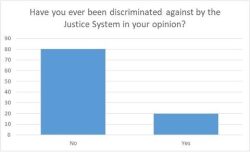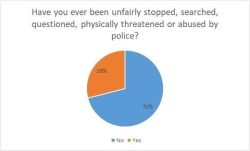
Features
Study: Systematic discrimination in southern Alberta
February 22, 2022 By Brittani Schroeder
Evaluation amongst minorities and immigrants (justice and policing)
The study
Canada is multicultural in its population and law. One would assume there would be no systematic discrimination towards minorities and immigrants in southern Alberta. Discrimination towards minorities and immigrants is documented in the Canadian Constitution and written as a law captioned in the Canadian Multicultural Act, 1988. However, what is the genuine life experience of these individuals in southern Alberta, and are their voices and concerns heard? Over the years, governments and policymakers have tried to give justice to this topic. It remains a concern within these communities, and we still see huge disparities resulting from systematic discrimination.
The initial premise is that systematic discrimination exists, and the Government of Alberta is doing little to tackle it. Therefore, this research aims to investigate systematic discrimination towards immigrants and minorities within various facets of the community in southern Alberta, Canada. One of the main research questions was, “Does systematic discrimination that can affect organizational transparency and performance exist in the justice system and policing departments in southern Alberta?”
The sample selected for the study consisted of 215 residents of southern Alberta. The study results showed significant discrimination cases in justice and policing systems among the minority and immigrant communities. This research will add more information to the existing pool of knowledge on discrimination and help policymakers develop intervention strategies to combat systematic discrimination.
Population and sample selection
A 2016 Canadian survey noted that there are 845,220 immigrants within the area (Canada Statistics, 2019). Also, various province institutions have been highlighted in prevalent news media and scholarly articles as having discriminatory tendencies towards minorities and immigrant individuals. As a result, Alberta province was selected as the population of the study, with a narrower, deliberate consideration of southern Alberta. There are two primary sampling techniques, which are probability and non-probability sampling. The non-probability sampling method was selected for this study based on convenience and proximity to the region of study.
Discrimination in the justice system

Figure 1.
This study investigated systematic discrimination among the minority and immigrant groups in southern Alberta, Canada. The research found significant cases of discrimination in the justice system. The justice system discriminated against about 20 per cent of the participants in this study. Most of the victims were immigrants, followed by individuals in the indigenous and visible minority communities. Dunn (2020), Godley (2018), and Slaughter (2020) also revealed that systematic discrimination was present in the Canadian justice system.
Does systematic discrimination that can affect organizational transparency and performance exist in the justice system and policing departments in southern Alberta?
Discrimination in the policing system

Figure 2.
Figure 2 summarizes whether the participants were stopped, searched, questioned, physically threatened, or abused by police for unfair reasons. The police had discriminated against only 29 per cent of the respondents. The discriminated respondents were Non-Caucasian (43.3 per cent), Caucasian (30 per cent), and other races (16.9 per cent).
A chi-square test of association investigated the presence of a significant association between race and discrimination by police. The chi-square test (14.475, p-value = 0.001) showed a significant association between race and discrimination by police. The result suggested that there existed discrimination in the policing system. According to Jacques (2017), data indicates that the black community is more likely to be subjected to disproportionate policing than the white. Further, Price and Payton (2017) reported that African Americans are more likely to experience lethal force from the police and are more likely to be shot and killed.
Conclusion
The results of this study represent a general phenomenon that several systems in southern Alberta, have systematic discrimination deeply rooted. These systems include policing and justice systems. There is strong evidence that systematic discrimination exists in the justice and policing systems.
References
Dunn, C. (2020, June 10th). Alberta RCMP deputy commissioner denies systemic racism in policing in Canada. CBC News. Retrieved from https://www.cbc.ca/news/canada/calgary/alberta-rcmp-racism-policing-1.5605360 on August 31st, 2020.
Godley, J. (2018). Everyday discrimination in Canada: Prevalence and patterns. Canadian Journal of Sociology, 43(2), 111-142.
Potvin, L. (2020). Black lives matter in Canada too! Canadian Journal of Public Health, 1-3.
Slaughter, G. (2020, June 4th). Five charts that show what systemic racism looks like in Canada. CTV News. Retrieved from https://www.ctvnews.ca/canada/five-charts-that-show-what-
Canada Statistics. (2019, July). Focus on Geography Series, 2016 Census. Retrieved from: https://www12.statcan.gc.ca/census-recensement/2016/as-sa/fogs-spg/Facts-cma- eng.cfm?LANG=Eng&GK=CMA&GC=810&TOPIC=
Sean Wentzel was born and raised in South Africa and served in the South African and British Army before immigrating to Canada. He worked for 10 years as a police officer. He enjoys his family and the outdoors, and loves what Canada has to offer. Wentzel holds a M.Sc. in Forensics and Criminology and a Doctorate of Business Administration.
Print this page